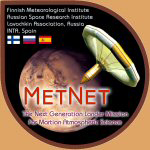
General circulation and climatological cycles
Dust is the dominant aerosol species and its source is the surface, which has a temporally and spatially varying dust cover. Dust is lifted into the atmosphere by different processes resulting in dust storm activity in widely varying spatial and temporal scales (ranging from short-lived dust devils through regional dust storms of days to weeks duration to hemispherical, even global dust storms lasting up to several months). Consequently suspended dust is a ubiquitous component of the Martian atmosphere. Observations and models indicate favoured seasons and (smaller-scale) areas of dust storm activity, which points to regional or mesoscale characteristics as well. Hellas impact basin and the polar cap edges are among the areas that exhibit frequent dust storm activity. The dust optical thickness has an approximate lower limit of 0.2, but during dust storms optical thickness is 5 or even more (Kahn et al, 1992). The dust effects on solar and thermal radiation (in turn highly dependent on the dust radiative characteristics) alter drastically the atmospheric thermal structure and consequently the circulation patterns.
Due to the low temperatures and the composition of the atmosphere, CO2 is exchanged between the seasonal polar ice caps and the atmosphere: CO2 condenses to the winter hemisphere polar cap and is sublimated from the summer hemisphere cap. This results in atmospheric mass being cycled between the caps and in variation of the mass of the atmosphere. Both of these processes are visible in, e.g., surface pressure observations, as demonstrated already by the Viking landers. The condensation/sublimation flow is hence also a manifestation of the CO2 cycle.


